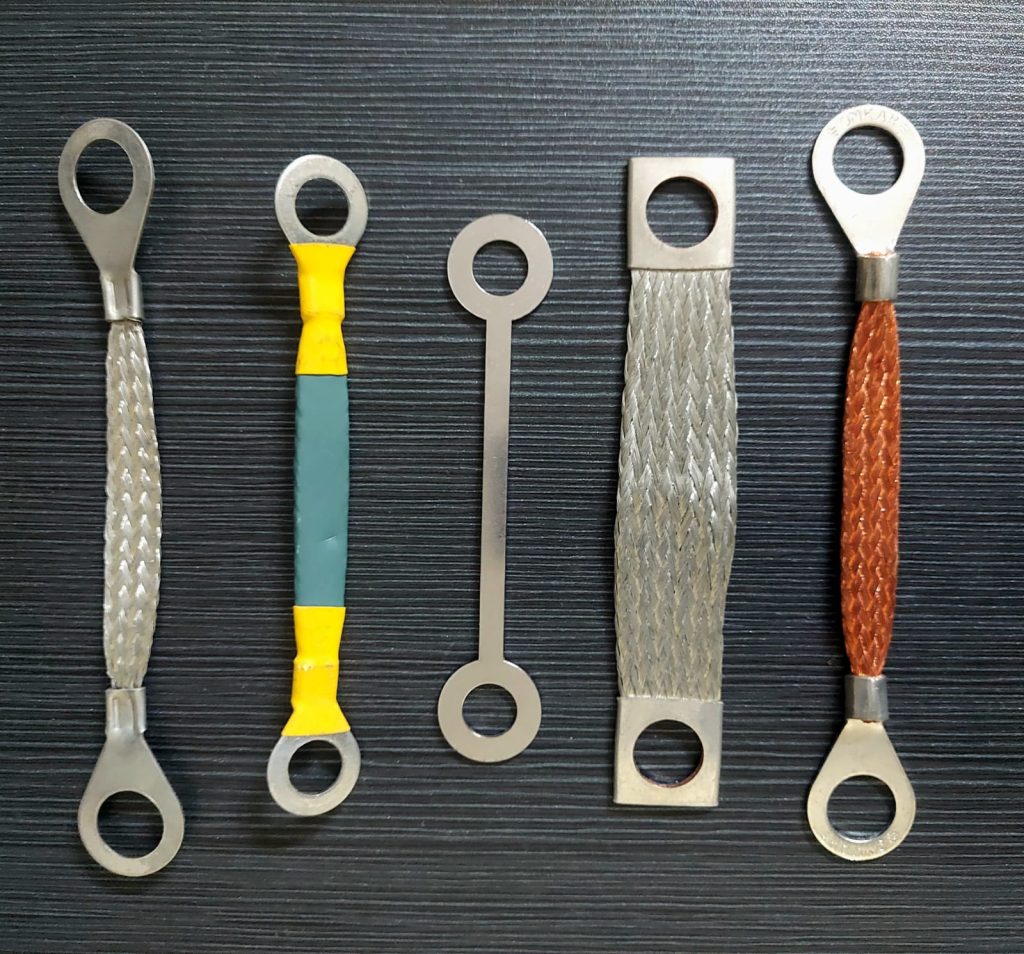Earthing components provide effective grounding and bonding solutions, which are essential for meeting safety standards. It is very important to choose, install and look after these parts properly if you want them to work effectively.

Construction: Straps, Wire, Jumpers
Type: Braided, Strip, Customized Design
MOC: Copper, Aluminum, Stainless Steel
Finish: Bare, Insulated, Electro-plated
#1. Earthing Straps
- Earthing Straps: Flexible metal strips or cables connecting electrical equipment to the earthing system, typically made from copper or aluminium for good conductivity.
- Applications: Essential in industrial settings for grounding large machinery, metal structures, and equipment that may become live due to faults.
- Design: Vary in width and thickness based on current-carrying needs; wider straps handle higher currents, suitable for high-power applications.
- Installation: Attached using clamps or bolts for secure connections, reducing risks of mechanical damage and corrosion.
- Sizing Guidelines:
- Width and Thickness: Should carry fault current without overheating; generally at least 25 mm wide for general use.
- Material: Copper is preferred for conductivity; thickness depends on application and expected current.
#2. Earthing Wires
- Earthing Wires: Conductive wires connecting electrical components to the earthing system, typically made from copper or aluminium, available in various gauges.
- Types:
- Solid Wire: Used for permanent installations, providing a stable connection.
- Stranded Wire: More flexible, ideal for applications with expected movement.
- Applications: Utilised in residential, commercial, and industrial electrical systems to connect appliances, panels, and other equipment to the grounding system.
- Sizing: Wire gauge is critical; it must be sized to handle maximum fault current without overheating. Standards like the National Electrical Code (NEC) offer guidelines for sizing based on application.
Determining Sizes for Earthing Wires:
- Current Rating: Size based on maximum fault current it must carry without overheating.
- Length of the Wire: Longer wires may need a larger gauge to reduce voltage drop.
- Soil Resistivity: Higher resistivity may require larger conductors for effective grounding.
- Standards for Sizing: Based on expected fault current and duration.
#3. Bonding Jumpers
- Bonding Jumpers: Conductive connections that link different grounding systems, ensuring all parts of an electrical system are at the same electrical potential for safety.
- Purpose: Eliminate potential differences between grounding points, preventing shock hazards in large installations with multiple grounding systems.
- Materials: Usually made from copper or aluminium, designed to safely carry fault currents; may be insulated or bare depending on installation needs.
- Installation: Must be installed according to electrical codes and standards, ensuring secure connections that are protected from physical damage. Often used with grounding bars or clamps.
Determining Sizes for Bonding Jumpers:
- Sizing: Should be based on the maximum fault current they may encounter, following principles similar to earthing wires.
- Connection Points: Ensure adequate sizing to connect different grounding systems without creating weak links.
Applicable Standards in India
– Code of Practice for Earthing, IS 3043: 1987.
– National Electrical Code (NEC) and International Electrotechnical Commission (IEC) standards may be referenced for specific applications, especially in industrial settings.
If you have any special requirements, please get in touch: info@visionexim.in. #earthingbraid #flangeearthing #stripearthing #earthingstrap
